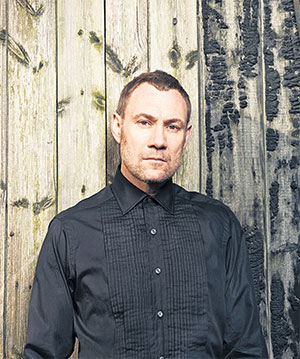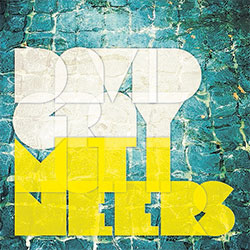David Gray’s creative transformation
Simply sign up to the Life & Arts myFT Digest -- delivered directly to your inbox.
Before we have even sat down, David Gray is enthusing effusively. I’m talking to the singer and songwriter at the Wallace Collection, the genteel gallery of Old Masters in central London, and I mention that there’s a portrait by Rembrandt of his son in the collection. Suddenly Gray – who has an art school background – is off on a verbal excursion to the Rijksmuseum in Amsterdam, homing in on a Rembrandt picture there called “The Jewish Bride”, of a father and his daughter. Gray is animated, passionate in his recollection of this tender portrait, extending his arm in emulation of the picture’s father with his loving arm around his daughter. Finally we sit.
Gray – trim, compact, a little wired – takes off his wraparound dark glasses and sets them on the table. His burst of passion sets the tone for our conversation: over the next hour or so he talks about the “joy” of re-inventing his way of working, the “intensity” of what he describes as a “creative transformation” in the making of his 10th studio album, Mutineers. Although he is suffering from what he describes as pre-album tension (“ ‘PRAT’, as my wife calls it”), he is clearly excited and proud of the album.
Yet it is unlikely to match the commercial success of his breakthrough release White Ladder in 2000 (which was, in fact, his fourth album): yielding more than 7m sales worldwide, and spawning the hit singles “Babylon” and “Please Forgive Me”, White Ladder transformed his life.
His enthusiasms spill over into realms other than art and music. I mention that there seem to be an awful lot of birds on the new album, with song titles such as “As the Crow Flies”, “Birds of the High Arctic” and “Gulls”, and he’s off, peregrinating into bird-land.
“I’m fascinated. It’s been the same with me since I was a small child. One of the first photos of me is from a holiday in Scotland. I’d been obsessed with seeing a golden eagle. I almost willed one into the sky, and eventually we saw one; then I built a wooden eagle on the beach out of driftwood, and that’s what the photo is of.

“The more I understand about them, the more enraptured I become. There’s a world of obliteration in birds – I lose myself in nature, forget about my thoughts; it’s the only time, apart from when I’m playing football, or watching football, that I let go, relax. It’s vital balm for the soul. There’s a beautiful passage by Keats about looking at sparrows in his garden – how he loses himself in the bird, becomes the bird, and leaves his feelings and thoughts somewhere else. He’s obliterated by what he’s seeing. That sort of describes the pleasure I get from it.
“At home [originally from Sale in Greater Manchester, Gray now lives in Hampstead, north London, with his wife and two daughters], I’ve got a wild garden. I’ve let it go completely mental, there are loads of birds nesting there – but so many of the nests don’t succeed, there are so many risks. It’s harrowing. We’ve got a little place in Norfolk and I bought binoculars – then you go further into the world of the bird. They are ‘other’, they sing, they’re of the sky.
“There are different themes on the new record, but one theme that runs through it is of far-flung places losing the human taint. I’ve come to realise that there’s always a part of me wishing I was somewhere like that. Wishing I was on St Kilda, living with storm petrels, sitting on a cliff. It’s probably to do with the level of saturation . . . It’s escapism. Getting out of the churning mechanism of the urban environment.”
Phew. And he’s scarcely begun. The real zeal is reserved for Gray’s new creative partnership with producer Andy Barlow – best known for his work with the electro duo Lamb – on the new album. Mutineers is a departure for Gray, with atmospherically charged, richly textured songs which don’t follow conventional structures: some are more like meditations, mantras. Gray expounds for minutes on end, employing all kinds of metaphors to describe his artistic awakening: he was a “creative carthorse” before Barlow “took the blinkers off”; together they went “off the map”, and Barlow gave him “the keys to the city”.
“I sat down at the piano after coming off the road,” says Gray, “after being the human cargo shipped around the world for however long, a decade, two decades of travel, and I just felt beaten up, dented, uninspired, bored of myself, at the end of myself.
“I didn’t want to just write about being a vaguely unhappy sort of middle-aged person. I wanted to say ‘hallelujah’ in a new way. But how do you make that leap? How does the lightning suddenly come out of the sky? I had to rebuild from the ground up. That person had to lie down and die. I called the album Mutineers because I had to throw myself overboard. I had to dismantle everything.”
To summarise a very long story, this involved Gray re-engineering his working methods to a degree that was, he says, “traumatic” – working from a lyric, working from a tiny scrap of music, working from soundscapes: anything but working conventionally on the “massive stash” of songs that Gray initially brought to the recording sessions, and which Barlow largely dismissed (“It’s a great song, Dave,” Gray recalls Barlow saying, “but I don’t know what I could do with it. Next . . . Next . . . ”).

At their height, the sessions brought moments of pure exhilaration, such as the title track of the album, which began life as a song called “Sugar Rush”. “We worked on it for a few hours,” says Gray, “and Andy said to me, ‘I love this bit. Why don’t we just lose the verse, and lose the chorus, and just work on that bit?’ And I said, ‘But there’s no melody, there’s no lyrics. Where does that leave me? I’ve got nothing.’ He said, ‘Just go with it, Dave, I think there’s something special.’
“Once we began to work, I found a new melody, that was the chorus, very simple, and a beautiful little guitar line to go with it. We just worked in a manic way for a day and a half,” says Gray. “At the end we were so overexcited we were leaping round the room hugging each other. Andy said, ‘Do you know what I was thinking when you sang that? Glastonbury main stage!’ And I said, ‘Me too. I was up there. The sun was going down. Oh yeah!’
“That’s what it should feel like. It’s the moment of searching and reaching – that’s what was captured on tape. God, it was so great to be somewhere else; new vistas of possibility instead of dead ends. That’s what happened when the process cracked open.”
The result is indeed a thing of beauty, beginning gently but spiralling off into near-ecstasy. But I wonder, too, what frightens him. “Death’s a bit scary,” he says. “I’ve had a good look at that. And then, more than death, bad reviews.” He does his head-thrown-back laughing thing. Then, after ruminating for a while, he clarifies: “To be dismissed as insubstantial – that’s definitely a fear. I’m a man for the mainstream, the big connection – that’s where I’m more comfortable. But don’t dismiss me as some wobble-headed inconsequential fuckwit; listen to the thing [the album] – there’s intricacy and depth as well as immediacy.”
Espresso cups are drained; time is up. In between birds and Barlow, Gray has riffed on early album purchases (he saved his school dinner money to buy Madness’s One Step Beyond), Leonard Cohen (“So gracious”), Ireland, where audiences kept faith with him in the pre-White Ladder wilderness years (“God bless the Irish”) and the resurgent popularity of the singer-songwriter (“My success was unexpected and suddenly it’s reproduced in a thousand pastel shades. But that wasn’t me. That’s not what I do”). As we get up to leave, he is still enthusing, about poetry: Seamus Heaney, Ted Hughes’s Crow. Those birds, again.
‘Mutineers’ is released on June 30. David Gray tours the UK, Ireland and the US from June 23; details at davidgray.com
Comments